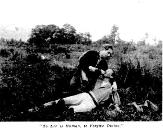 6717137538083471651.jpg
6717137538083471651.jpg
 6717137538083471651.jpg
6717137538083471651.jpg
'It contains the life history of Joe Gilchrist, a convict, transported by the English Government to Western Australia, for some trivial offence. Gilchrist, known as Convict No. 406, has earned the enmity of a fellow prisoner, named Isaac Bowman, who determines to ruin him, and concocts a robbery from a settler's home, endeavoring to cast suspicion on Joe Gilchrist; his plot, however, fails, and he is lashed at the triangle, while Gilchrist counts the strokes. Later, Bowman is released as a free settler, and takes up a selection away back on the outskirts of the Vasse Valley. All free settlers had a right to select a convict servant, and Bowman selects Joe Gilchrist. For a term Gilchrist lives his life regardless of the brute man who was his master, but one day he struck his enemy down. This offence, by an assigned servant, meant the chain gang at Freemantle for life—one of the most hideous and dreaded of punishments—so Joe took to the bush. Befriended by the natives of the Vasse Valley, for years he lived in their stronghold, and was named by them '"Moondyne," the great white chief. The natives, when visiting the more populated districts, were frequently seen wearing crude golden ornaments. Governor Hampton issued a proclamation offering £5000 reward for the discovery of the mine from which the natives of the Vasse obtained their gold. The effect of this was fruitless; but the whites were ever on the alert to trace the source of this mysterious wealth. Moondyne, as one of the Vasse tribe, has learnt the secret. One day, on the summit of the ranges, a native sees a police party, and knows their territory is endangered; he informs the chief—Te-Mana-Roa. Moondyne with a party proceeds to investigate. The party are ambushed and Moondyne is recaptured, and to his horror once more discovers his life's enemy, Bowman, who, retired from the land, has now become a sergeant of police. He is manacled to Bowman's horse, and the cavalcade proceeds to return to civilisation. On the road, Moondyne arouses the cupidity of Bowman, and informs him he is in possession of the secret of the mountain of gold—the price is his freedom. Bowman accepts, and effects the escape of Moondyne, and accompanies him to the Vasse Valley. The chief, on the return of Moondyne, agrees to respect his promise and disclose the secret of the golden mountain to Bowman, but refuses to permit his departure. Later, however, Bowman, in the absence of Moondyne, half kills the chief, seizes as much gold as he can carry and rides off. Moondyne is banished by the tribe, and rides for his revenge on the tracks of his enemy. Bowman loses the track, and perishes on the verge of the plains, but not before Moondyne has found him, and instead of killing, endeavors to succour Bowman with his last drop of water. Next morning, a native discovers two forms lying still upon the plains. Moondyne lived to return to the Vasse Valley and the love of his friendly natives.'
Source:
'Moondyne', Daylesford Advocate, Yandoit, Glenlyon and Eganstown Chronicle, 24 February 1914, p.3.